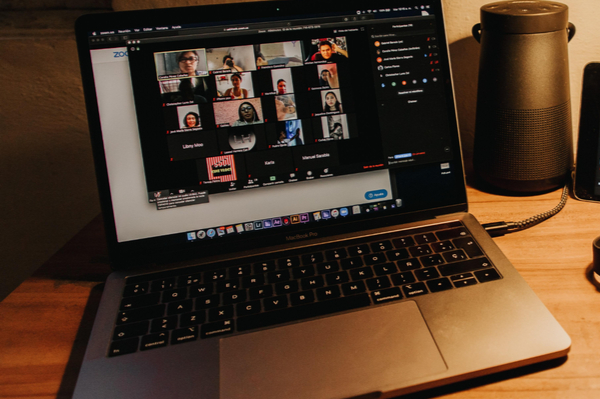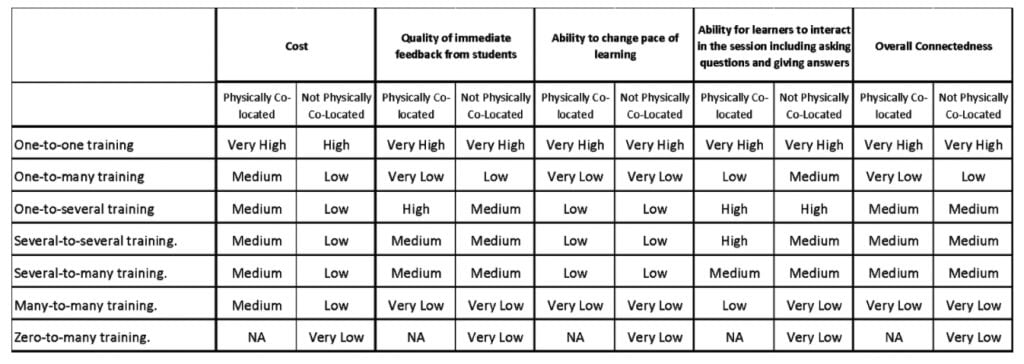
The Merriam Webster dictionary defines ‘face-to-face’ as:
1: within each other's sight or presence;
2: in or into direct contact or confrontation.
The first of these definitions allows that face-to-face can happen via videoconferencing technologies. 21st century technology enables people to be within each other’s sight even though they are physically apart.
Of course, there are other dictionaries and other definitions.
Why do I think that the question of whether face-to-face can happen at a distance is interesting?
Fairly obviously in this current health crisis, physical co-location is often not possible nor desirable. So we need to find different ways of connecting educators and learners.
I want to focus on this idea of ‘connection’ which is at the heart of why we think that ‘face-to-face’ interaction is important. Brilliant training requires a strong interconnection between the trainer and the learner/s. If you are connected you are engaged. A one-to-one coaching session delivered virtually is far more connected and engaging than a 200-person lecture in a physical lecture hall where many of the students may not even be listening.
We have stopped using the term ‘remote’ or ‘distance’ learning at Corndel because we think those terms imply a lack of connection. We work tirelessly to ensure that all of our interactions with students are strongly connected and engaging - whether or not they are delivered in the same physical space.
In this context, it is very possible to deliver face-to-face, engaging training connected by technology rather than connected by physical co-location.
The most important element for connection in virtually any training is the ratio of students to teachers. Ceteris paribus, the smaller the classroom size, the more the learning can be tailored to each individual learner’s needs and the pace that is most appropriate for them.
It might be helpful to distinguish between seven different types of learning based on the number of teachers and learners to expand on this idea.
1. One-to-one training. This is where there is one ‘teacher’ and one ‘learner’. For example, a personal coaching session or a 1-1 tutorial.
2. One-to-many training. This is where there is one ‘teacher’ and many ‘learners’. For example, a lecture.
3. One-to-several training. This is where there is one ‘teacher’ and several ‘learners’. For example, a workshop.
4. Several-to-several training. For example, a seminar.
5. Several-to-many training. For example, a panel discussion.
6. Many-to-many training. For example, a large meeting.
7. Zero-to-many training. For example, an online course where there is no, or very limited, human interaction with a ‘teacher’.
These different forms of training have different advantages and disadvantages and are more or less amenable to online delivery. The table below evaluates the different types of training, (in both their physical and virtual manifestations), according to:
- Cost – how expensive that provision is to deliver.
- The quality of immediate feedback from students. How easy is it to see if people are struggling to keep up or are not understanding concepts? Can teachers see if students are listening and engaged?
- The ability to change the pace of the learning. For example, if learners are finding the session too slow.
- The ability for learners to interact in the session including asking questions and giving answers to questions posed.
The final column of the table gives an overall connectedness rating based on the last three of the four bullet points above.

One-to-one training is very connected whether delivered in physical proximity or physically apart. It is also very expensive. In training, you get what you pay for.
One-to-many training is much less connected, and, perhaps surprisingly, can actually be more connected without physical proximity. This is because large groups can ask questions and give feedback using videoconferencing platforms’ whiteboard, polling and other online functionality.
One-to-several, several-to-several and several-to-many training can be reasonably connected either delivered in physical proximity or not.
Many-to-many training is chaotic and unconnected in person and even more so remotely.
Zero-to-many training is cheap but very hard to really tailor to the needs of a learner. For all the talk of machine learning, big data and sophisticated algorithms, artificial intelligence is light years behind a good human teacher at adapting teaching appropriately to address learners’ specific needs.
The education world has known for centuries that the lower the ratio of the taught to the teachers the higher the quality of the education. The move to 100% non-co-located training in light of the current health crisis doesn’t change this.Quality, face-to-face training can still happen at a distance. It just needs a great trainer and an appropriately small number of students.
If you want to share your thoughts on, or experiences of, managing through the crisis, get in touch with us via email or use #BetterManagers on Twitter or LinkedIn.
You might also like these posts on this topic:
Saving lives with NHS Chartered Managers
CMI Chartered Manager accreditation is improving outcomes throughout Royal Berkshire NHS Foundation Trust.
Building careers through lower-level apprenticeships
Read about Skillwise, a private training provider that helps employers to invest in their managers through CMI EPA.
“I’m a big fan of educating myself as much as possible”
Carl Nielsen ChMC says becoming Chartered allowed him to reflect on his strengths, weaknesses and identify areas for growth
Can AI play a meaningful role in developing and nurturing human talent?
How businesses can harness AI’s potential while addressing ethical challenges
Don’t miss out - get notified of new content
Sign-up to become a Friend of CMI to recieve our free newsletter for a regular round-up of our latest insight and guidance.
CMI members always see more. For the widest selection of content, including CPD tools and multimedia resources, check out how to get involved with CMI membership.
Blog
This is a space for people to stay up-to-date with all the latest knowledge, opinions and commentary on management and leadership topics from some industry leaders.
Members See More
CMI Members have access to thousands of online learning and CPD resources. Learn more about our membership benefits
Join The Community
CMI offers a variety of flexible membership solutions, tailored to your needs. Find out more and get involved in the CMI community today.
